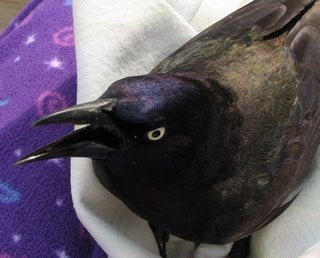Grackle Gets a Second Chance
 The window on the deck door has been a quick and brutal stopping point for a few birds. Although we have decals and a hanging crocheted decoration on it, when the hawk chooses our backyard for lunch, the bird they are chasing only seems to look at the empty spaces between the decals. The south sun hits that door causing deep reflections of the woods.
The window on the deck door has been a quick and brutal stopping point for a few birds. Although we have decals and a hanging crocheted decoration on it, when the hawk chooses our backyard for lunch, the bird they are chasing only seems to look at the empty spaces between the decals. The south sun hits that door causing deep reflections of the woods.Last week, while in another room I heard the dreaded sound of something hitting that window, but this was much louder than any I'd heard before. I actually wondered if the hawk had hit the window this time.
Running to through the screened porch and onto the deck to see if there was any hope of saving the bird, I discovered a Common Grackle on its back still breathing heavily with its beak open.
I quickly got an old pillowcase from the porch tub where such things are kept for cats and critters. I didn't want to get scratched from the claws and I knew he'd feel safer with a firm grip and the ability to wrap the fabric around him. Birds feel safer if the world goes dark.
The Common Grackle is from 11-13 inches long, so it was a large bird. The Grackles had arrived in early March, three weeks earlier, as they do during migration. We see them in the Fall and Spring. They raid the feeders and chase away most of the other birds since they come in groups and are quite gregarious and not very friendly. They will even attack other grackles at times.
We can enjoy them since they do not remain here. Their iridescent coloring makes me want to call them Rainbow Birds. Their preferred habitat is open areas and we are forested. They prefer coniferous trees and ours are hardwoods. They don't mind sharing space with humans, and are quite common in suburban areas, farmlands, orchards, and city parks.
The clearing of forests for agriculture has resulted in an expansion of the range of the Common Grackle which has also increased their numbers. They are one of the most successful and wide-spread species in North America.
They are known to help control pests in crops, but are generally not liked in corn fields. We enjoy them being around at this time of year since they dig in the dirt with their bills for food and will happily consume Japanese Beetle grubs. To encourage them finding the grubs, we scatter cracked corn in the areas where we have problems with Japanese Beetles.
Predators of this bird that eat the eggs and/or nestlings are squirrels, snakes, raccoons, chipmunks, and cats. The adults are food for a variety of hawks and owls.
During migration and in winter, Common Grackles like to eat grains and seeds from farm fields, such as corn and acorns. They will eat fruit if available. While breeding, their diet mostly consists of insects, frogs, salamanders, crayfish, minnows, earthworms, mice, and even small bats they catch in the air. They are very opportunistic foragers and will follow a plow in search of grubs.
Feeding in groups they make themselves known as they sit in trees or feed on the ground. They use a lot of vocalizations to communicate and produce a harsh song that sounds much like a squeaky, rusty gate.
Our visitor was totally alone which is another reason to believe it was the result of a hawk chase. There were no birds to be heard or seen when I arrived on deck. I held the grackle on my lap while I gave it some Distress Remedy, a formula well known among animal owners and rehabilitators since it helps greatly when an animal is in shock or trauma or very stressed.
The grackle responded well to the few drops which I placed on the tongue. The beak was hanging open. I didn't want to put anything down its throat since I didn't know if it could swallow. I'm so glad I was there to help.
When it seemed to be improving, I put it in a box and closed the flaps. Birds feel very secure in the dark and in an enclosed area. This seemed to finish off the brief rehabilitation process since it was scratching around in 5 minutes. I took it to the front porch hoping to see a group of friends that might call.
It seemed I had a female since the tail was shorter than most and that's one indication of a female. They are not as vocal as the males and they weight a bit less also.
As I began to turn the box so I could open the flap on the end providing the bird a platform to look around from and depart, a few birds came back into the yard. It seemed only a moment longer that I could see the head appear near the end of the box. Once she saw the open pathway to freedom, she took off with such a strong flight pattern turning after maneuvering through a couple of trees.
I was so delighted that it had done so well so quickly. Please be sure to view the rescue in photos.



0 Comments:
Post a Comment
<< Home